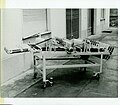Leo Morandi
This article has multiple issues. Please help improve it or discuss these issues on the talk page. (Learn how and when to remove these messages)
|
Leo Morandi | |
|---|---|
 | |
| Born | 14 November 1923 |
| Died | 2 May 2009 (aged 85) |
| Nationality | Italian |
| Occupation(s) | Inventor, entrepreneur, marketer |
| Known for | Commercial ceramics |
Leo Morandi (14 September 1923 – 2 May 2009) was a promoter of the new post-World War II commercial ceramics industry of Sassuolo, Italy. At first he collaborated with local ceramic producers (Marazzi Group) and with Industries D'Agostino in Salerno, Italy. In 1954, after selling an innovative patent to Ceramiche Marazzi (biscuit selection unit), he was able to initiate startup of his own equipment supply business. Leo Morandi's innovations, knowledge, and experience aided growth and advancement throughout the Sassuolo ceramic companies, which in the 1960s constituted the worldwide known Sassuolo tile district.
Impact on industry
[edit]In particular, he used two electrodes to select the biscuit; the passage of electricity through the material showed that it was not suitable for the successive glazing.
The production chain for ceramic tiles was then mainly handcrafted and labour-intensive, but Leo Morandi's inventions started the successful automation of various units. After the initial years he was able to open a distinct efficient production unit. Morandi was a reserved man and did not like publicity. He involved his workers and customers in the improvement of his inventions and innovations.

Ceramic industry equipment examples include: automated floor tile edge glaze remover, automated packaging (floor tiles where historically bound with thin iron wire, before shipment), specialized silk screen machines, the peristaltic pump, the transport line, the hydraulic press, tile overturning mechanism, press reception unit, and glazing applications done with disk booths. These basic tile processing elements are still in use.
Leo Morandi began exporting these proven automated Italian ceramic industry innovations to Spain, allowing advancement of two primary ceramic industry clusters.
Licences of Officina Morandi Leo, Sassuolo
[edit]
1945 - 1 December Licence n.424701
Device to abrade automatically the enamel from the edges of the floor tiles for covering.
1958 - 14 June Licence n.592220 System to fasten with iron threads tiles of geometrical shape.
1958 - 1 August Licence n.598125 Machine to remove automatically from the tiles the enamel strains left on the edges during the humid glazing
1958 - 1 August Licence n.593124 Device to brush tiles on both sides with a single passage.
1958 - 2 August Licence n.593126 Automatic machine to remove from the tiles the slobbers left by the stamps on the edges.
1958 - 2 August Licence n.593127 Pump for dense liquids, particularly for vitreous enamel in watery suspension for the ceramic industry.
1958 - 25 September Licence n.595789 Machine to retrieve the vitreous enamel of the tiles which result defective after the humid glazing.
1959 - 6 April Licence n.606642 Procedure to manufacture enameled tiles with dull edges.
1960 - 7 April Licence n.629034 Automatic machine in order to collect into a pile humid tiles coming from the press.
1961 - 7 April Licence n.646867 Conveyor for ceramic floor tiles.
1961 - 7 April Licence n.646866 Device to turn over the tiles on the conveyor.
1961 - 15 April Licence n.647228 Machine to divide the tiles by thickness.
1962 - 28 March Licence n.685219 Hydraulic system, consisting in a press actioned by mostly self-feeding cylinders.
1968 - 13 March Licence n.832329 Automatic machine to apply screen printed decorations to tiles.
1973 - 6 Decembers Licence n.1001087 Device to distribute the tiles being part of a row.
1973 - 6 Decembers Licence 1001086 Device to empty the baking supports of tiles.
1978 - 12 April Licence n.1104063 Perfected device with rotary discs to nebulize and evenly distribute enamels to be applied on tiles.
1978 - 3 July Licence n.28979B Glazing cabin with rotary discs to nebulize and evenly distribute enamels to be applied on tiles.
Image gallery
[edit]This section may require cleanup to meet Wikipedia's quality standards. The specific problem is: unorganized collection of images. (November 2024) |
-
Letter of intent Morandi-Marazzi pag.1
-
Letter of intent Morandi-Marazzi pag.4
-
Catalogue Morandi's silk screen machine S1
-
Catalogue Morandi's silk screen machine S2-S3
-
Morandi's fastening device
-
Leo Morandi near the device to abrade the edges of the tiles(1945)
-
Morandi's device to abrade the edges of the tiles in his factory(1945)
-
Morandi's Automatic machine for collecting into a pile ceramic tiles from the pressed one
-
Licence n.424701
-
Licence n.685219
-
Licence n.424701
-
Morandi's lines "60"
-
1945 Morandi's glazing line
-
Licence n.598125
-
Morandi's out press device
-
Morandi's 1970 glazing line
-
Morandi's first silk screen machine
-
Morandi's first silk screen machine
-
Morandi's silk screen machines ready for Spain
-
Morandi's third serie silk screen device
-
Morandi's disc cabin glazing unit
-
Morandi's glazing lines "60"
-
Catalogue Morandi's silk screen machine S4-S5
External links
[edit]Sources
[edit]- Margherita Russo: Distretto industriale e servizi di trasporto. Il caso della ceramica, Franco Angeli, Milano, 1990 (in Italian)
- Margherita Russo: Cambiamento tecnico e relazioni tra imprese. Il distretto ceramico di Sassuolo, Rosenberg & Sellier, Torino, 1996 (in Italian)
- Alberto Lusoli: Internazionalizzazione dei distretti
Il distretto ceramico di Sassuolo [1] (in Italian)























